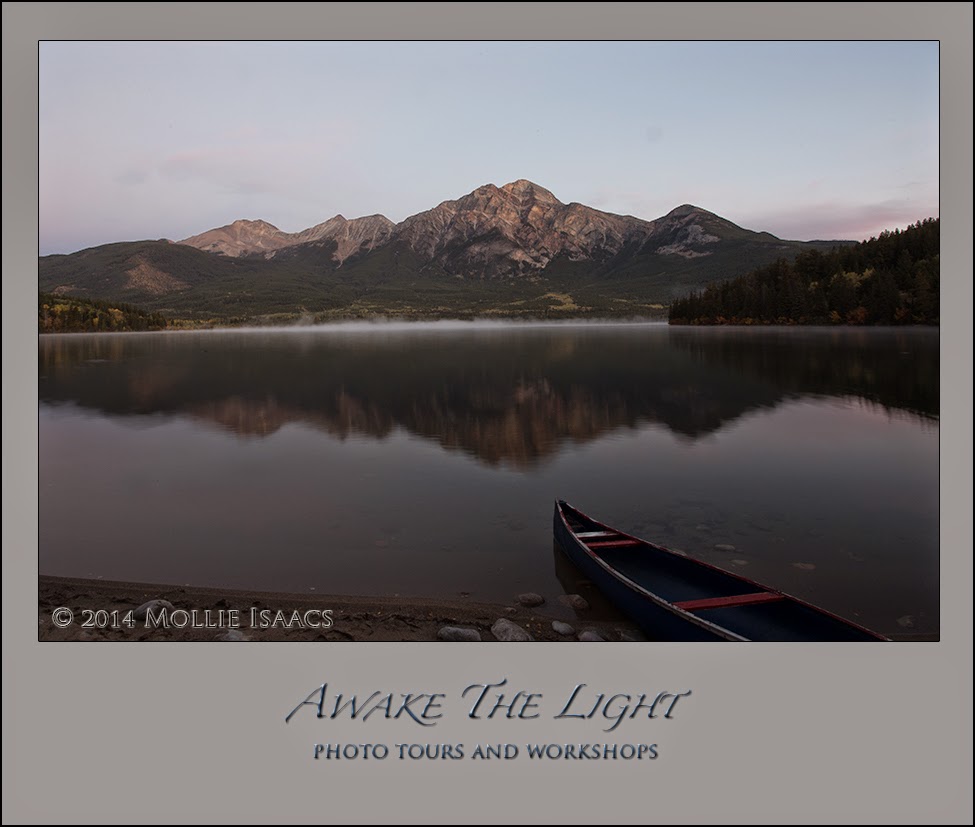I feel very fortunate to be spending the month of September
in the Canadian Rockies on a photographic sojourn. My good friend and superb
photographer CL is traveling for several months in the west, and invited me to
join her for part of the time. It seems that around nearly every bend in the
road we find something to photograph.
We were traveling along the Icefields Parkway in the
northern reaches of Banff National Park when we saw several people parked along
the side of the road near a bridge. In most places that is a sign that wildlife
is nearby. We pulled over safely onto a wide shoulder, grabbed our cameras and
got out to take a look. As we walked back to the bridge, which spanned a deep
river gorge with a waterfall and a rocky, fast-moving stream, we saw an amazing
scene of animal behavior play out. Here is the overall scene on the right.
 |
| Narrow but dangerous chasm. Note the rock marked. |
We saw a line of about 8 female bighorn sheep, some with
young, walk out from under the bridge and up the sheer, rocky sides of the
gorge, looking for a way to cross the raging torrent safely. It was going to
take a hefty leap for them to get across the chasm. The alpha female walked
slowly across, then up and down, the steep cliff face to get a better view. She
appeared to be seeking the narrowest section of the chasm, and a jumping off
point that was higher than the potential landing spot on the other side. She
seemed to see a way across, stood still for awhile, appeared to study the
options,
 |
| Alpha female changed her mind,turned around. |
|
but then apparently thought better of it and turned away from the
gorge.
All the other sheep stood patiently in line, obviously
waiting and watching to see what the alpha female would do.
There was more reconnoitering, more walking along the cliff
face. It is miraculous how these animals can stand on and climb up apparently
sheer rock. The tiniest ledge, just wide enough for their hooves, is all they
need. Their feet are so well-adapted that they can effortlessly traverse
seemingly impossible places.
This whole decision-making process took what seemed like a
long time, perhaps five minutes or more. All the while, the increasingly large
group of human onlookers watched in awe and some trepidation, fearful of the
possible outcome.
Finally, with no warning and no sound, the lead female
effortlessly bounded from a standing position,
 |
| The start of the leap. |
vaulted across the chasm, and
landed safely on the other side. Her eyes looked straight ahead, and she calmly
walked forward after her soft and controlled landing.
 |
| Successful leap. |
The others followed her lead, and one at a time each bounded
just as effortlessly and safely across. Once the last one had successfully
leapt across the chasm,
 |
| Safe landing. |
the 2-legged onlookers cheered, applauded, and breathed
a sigh of relief. We knew we had witnessed a potentially dangerous situation
for the sheep, and all came through it safely, and with style and grace. What a
privilege to have watched such a scene.
TECHNICAL DATA
Shutter Speed 1/1000 sec.
Aperture f/9. ISO 400. Lens: Canon 70-200mm f/4L IS with 1.4x
extender for an effective length of 280mm.
Camera: Canon 5D Mark III.
Handheld.
TODAY’S QUOTE: "The continued existence of wildlife and wilderness is important to the quality of life of humans." --Jim Fowler


































